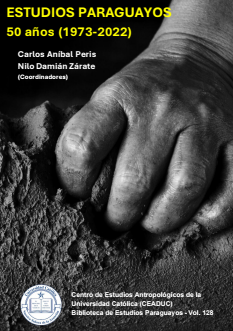Indigenous populations in urban contexts, identity and political power
DOI:
https://doi.org/10.47133/respy2500203Keywords:
urban indigenous population, ethnic identity, ethnic borders, political power, land and territoryAbstract
Indigenous populations in urban contexts constitute an increasingly present actor in the social, political, and cultural reality of cities in Paraguay. The present text is the advance of a more extensive investigation that delves into the identity determinants of the same, settled in the capital Asunción and its Metropolitan Area, through the theoretical approach and the empirical anchors of the elements of the observed reality. Categories such as identity, ethnic identity, ethnic borders, collective identity, land and territory, allow us to understand and configure the edges of a social phenomenon that has been strongly projected since the 1990s and is positioned towards the first quarter of the 21st century, as an issue that if it is not addressed seriously and rigorously with respect for consecrated and customary rights, it can become a tinderbox at the gates of central political power. It exposes the statistical circumstances of the communities, settlements and clans; outlines the visible characteristics of the progressive constitution of a collective identity that starts from feeling indigenous as a determining and cohesive imperative; explores the intricacies of the tensions with the political power that initially displays an action and management of denial towards the recognition of the existence of indigenous people living in cities; and anchors the reflection on the problem of land and territory in general and in the urban sphere, its possession and intrinsic link with the constitution of indigenous societies as part of an ancestral totalizing and totalized culture: its cosmogonic configuration and its dynamic identities.
Downloads
References
Aravena, A. (1988). Territorio y etnicidad. La identidad indígena en los medios urbanos. Una reflexión teórica a partir de los actuales procesos de recomposición de la identidad étnica Mapuche en la ciudad de Santiago. III Congreso Chileno de Antropología. Colegio de Antropólogos de Chile, Temuco.
Barth, F. (1976). Los grupos étnicos y sus fronteras. La organización social de las diferencias culturales. Fondo de Culruta Económica, México.
Bengoa, J. (2000). La emergencia indígena en América Latina. Fondo de Cultura Económica, México/Chile.
Bogado, M. (2014). Una aproximación a las identidades de la Zona Metropolitana de Asunción. REVICSO, 1(1), 79-102.
Bogarín, I., Galeano, B., & Rodas, A. (2002). Seguimos siendo mbyá guaraní. Testimonio de una familia indígena asentada en Cateura desde el año 1998. Suplemento Antropológico, 37(2), 421-527.
DGECC. (2005). Resultados del Censo Nacional Indígena de Población y Vivienda 2002, serie de Condiciones de vida. DGECC, Asunción.
DGECC. (2014). III Censo Nacional de Población y Viviendas para Pueblos Indígenas. DGEEC, San Lorenzo.
Dirección General de Estadísticas, Encuestas y Censos. (2014). Censo Nacional de Población y Viviendas para Pueblos Indígenas 2012. DGEEC, Fernando de la Mora.
Fogel, R. (2010). Los pueblos Guaraní en la formación de la nación paraguaya. CERI-UNP-FONDEC, Asunción.
Hall, S., & Du Gay, P. (1996). Cuestiones de identidad cultural. Amorrortu, Buenos Aires.
Ley 904/1981, de 10 de diciembre de 1981, Estatuto de las comunidades indígenas. https://www.bacn.gov.py/leyes-paraguayas/2400/ley-n-904-estatuto-de-las-comunidades-indigenas
Melucci, A. (1996). Challenging codes. Collective action in the information age. Cambridge University Press.
Robins, W. (1999). Etnicidad, tierra y poder (Vol. 32). Biblioteca Paraguaya de Antropología, Consejo Nacional de Pastoral Indígena y Centro de Estudios Antropológicos de la Universidad Católica Nuestra Señora de la Asunción, Asunción.
Telesca, I. (2018). Pueblos de Indios y tierra en el Paraguay de Carlos Antonio López [Ponencia]. XI Taller: "Paraguay desde las Ciencias Sociales". Grupo de Estudios Sociales sobre Paraguay IEALC-FSOC, Universidad de Buenos Aires, Argentina, Universidad Nacional de Pilar, Paraguay.
Verón, L. (2017). Beláiev, el redentor de los maká. Edición de Autor, Asunción Paraguay.
Published
How to Cite
Issue
Section
License
Copyright (c) 2022 Miguel H. López; y Estudios Paraguayos

This work is licensed under a Creative Commons Attribution 4.0 International License.
















